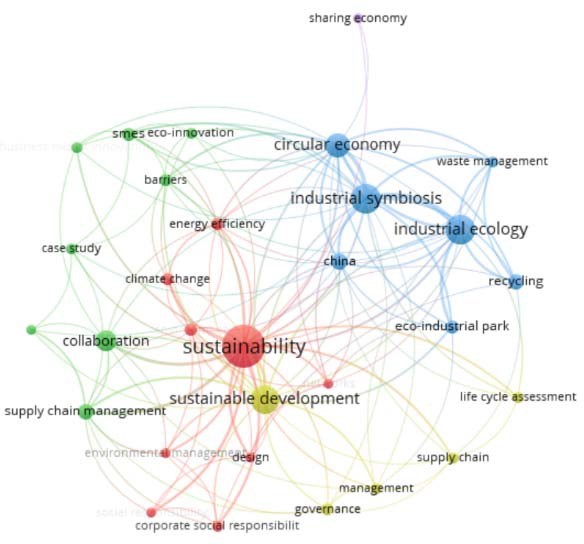M. Ormazabal1![]() , F. García, C. Jaca1
, F. García, C. Jaca1![]() , J. Rincón-Moreno1
, J. Rincón-Moreno1![]() and M. J. Alvarez1
and M. J. Alvarez1![]()
1 Tecnun Universidad de Navarra. Manuel de Lardizabal,13 Donostia 20018. Spain
Keywords: Industrial Symbiosis, Circular Economy, Drivers, Barriers
1. Introduction
We currently live in a society where companies’ business models are based on extracting, manufacturing, using and wasting. However, these models are not sustainable over time, due to the fast rate of consumption. In response to this consumption model, the circular economy comes into play with the objective of ensuring that resources in general maintain their value at all times. In this sense, industrial symbiosis (IS) can help in the objectives of the circular economy by encouraging collaboration among companies. IS has been defined as engaging “traditionally separate industries in a collective approach to competitive advantage involving physical exchange of materials, energy, water, and by-products” [1]. Other collaborations, such as joint transport agreements, and shared machinery and facilities between different organizations, can also be considered IS. However, although there are some successful IS cases reported in the literature, it is also noted the fact that industrial symbiosis collaborations are still scarce and difficult to initiate. The main objective of this study is to analyze the factors that drive IS to boost them as well as the barriers in order to mitigate them.
2. Methodology
We carried out a literature review with the aim of studying the fostering factors of implementation of IS that the scientific community have identified. As a first step, we created the following four groups of keywords according to the objectives of the study: Sustainability, Industrial Symbiosis, Drivers or Barriers and Companies. From these groups of words, a query was designed for the Web of Science database and the search fields selected for the recovery of the scientific literature was the Topic (TS) for the period up to 2018. The obtained papers (1,656) were analyzed with the scientometric software called VOSviewer in order to obtain a two-dimensional map in which the words are organized according to their similarity [2]. Finally, a manually performed review was conducted for each of the papers, and only those that had a direct relationship with drivers or barriers in an industrial symbiosis context were selected. With the final list of results, made up of 40 articles, an analysis of the main drivers and barriers was carried out.
3. Results
The 1,655 obtained articles were analyzed with the VOS Viewer. The selected unit of analysis was “Author keywords” with a “Co-occurrence” [3]. In Figure 1, it can be observed that “sustainability” is the keyword with the most occurrences and with the most relationships, followed by “industrial symbiosis and industrial ecology”.

The literature review allowed us to identify the most significant drivers and barriers, which were classified into the following groups: new partnerships, internal commit- ment, external support and legislation, technology and economical aspects.
4. Conclusions
This study has allowed us to identify the drivers and barriers that companies can find when implementing IS. Fostering IS enablers and mitigating barriers is important to accelerate the transition towards the circular economy, which is so necessary in the context of global environmental demands.
It should be noted that, as observed in this study, many of the barriers that have been identified coincide, turned around, with the drivers. It is therefore very important that all the involved agents work in the same direction, promoting the facilitators and minimizing the barriers. In this sense, it is necessary that all the involved agents do their part: public administrations, clients, associations, companies, etc. Overcoming these barriers would need that the involved agents share a common strategy for implementing solutions and in turn uncover some potential opportunities. Thus, it is important that the different agents come together and commit themselves to sustainability to overcome barriers to innovative solutions.
The different facilitators such as public agents, universities, associations, or research centers can act as promoters of IS actions and fruitful collaborations. Furthermore, these facilitators can be responsible for ensuring that many of the factors identified are considered as drivers rather than barriers, highlighting the benefits that collaboration between industries can bring. Such facilitators may be able to stimulate the diffusion of IS through the development of a common agenda of collaboration.
In this regard, it is important that facilitators create a collaborative framework in which companies feel comfortable to exchange information and in which therefore a climate of trust can be created. Subsequent studies should clearly identify the different stakeholders, their role within the IS in order to minimize possible barriers and promote IS. This approach might improve a facilitative leadership that creates positive interactions to nurture relationships between stakeholders and thus, can increase the benefits of IS.
Acknowledgments. The authors would like to acknowledge the financial support provided by the University of Navarra (PIUNA program).
References
- Chertow, M.R.: “Uncovering” Industrial Symbiosis. J. Ind. Ecol. 11, 11–30 (2007).
- Paes, L.A.B., Bezerra, B.S., Deus, R.M., Jugend, D., Battistelle, R.A.G., 2019. Organic solid waste management in a circular economy perspective – A systematic review and SWOT analysis. J. Clean. Prod. 239, 118086.
- Van Eck, N., Waltman, L.: Software survey: VOSviewer, a computer program for bibliometric mapping. Scientometrics 84, 523–538 (2009).
